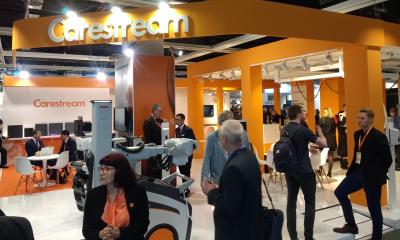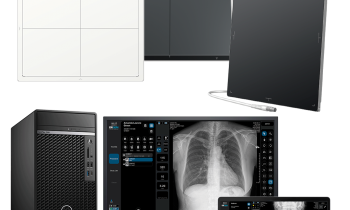Are you safe?
EuroSafe Imaging is a wake-up call, an ambitious campaign launched by the European Society of Radiology (ESR) to increase awareness about the risks of radiation in medical imaging, but also to better promote the benefits of exams.

in Paris.
Some radiologists may be tempted to hit the ‘snooze’ button, believing that radioprotection of patients is a tired topic, not worth their attention at this year’s European Congress of Radiology (ECR) in Vienna. This would be a mistake. According to ESR President Guy Frija MD, anyone concerned about daily workflow, CT exam protocols, and the cost of doing business in radiology, needs to think differently. The landscape in Europe is shifting. He respectfully suggests radiologists plan on joining the discussion during the launch session of EuroSafe Imaging entitled ‘Dealing with Challenges of Radiation Protection’ at this year’s congress. ‘This topic is not very sexy for radiologists,’ he admits, yet as he wrote in the ESR Statement On Radiation Protection, ‘radiation protection has become a worldwide issue and the [society] considers it as its responsibility to act.’
Dr Frija notes that ESR ‘is aware about the increasing inappropriate medical exposures to ionising radiation and wide variation in patient doses for the same examination… and realises the compelling need to act against the lack of adoption or adherence to requirements.’
Key words to keep in mind are regulation, guidelines, audits and certification.
‘We will be increasingly challenged to demonstrate the appropriateness of our exams, to show they are clinically justified. This becomes very significant,’ he said in an interview with European Hospital.
Thanks to impressive innovations and advances by industry, radiologists may have been lulled into complacency about radioprotection. Some believe that the issue is behind them, thanks to what has been called the magic button for iterative reconstruction that renders a diagnostic quality image from ultra low dose exposure for the patient. ‘They are right and at the same time wrong,’ said Dr Frija. ‘It is true that with iterative reconstruction we have diminished dose exposure considerably, from 50% to 70%. Yet they are wrong because today the scientific view held in esteem around the world, the linear no-threshold model, says that even an infinitesimal dose of radiation has a potential risk.
‘This is no more than a hypothesis that has never been proven. Yet, even if some believe that low dose exposure does not carry a risk, they are wrong to dismiss the patients’ concerns. The key goal is to assure the patient who may be worried. Rather than disputing this hypothesis, we are going to frame the radioprotection discussion as a matter of benefit and risk for an exam,’ he said.
Radiologists, he pointed out, need to know how to explain to patients that the best protocols possible and best equipment, are being used in the best interest of the patient.
During this year’s ECR opening ceremony, Dr Frija will officially introduce the EuroSafe Imaging campaign that he has personally taken up as the Centrepiece of his ESR presidency. The fullness of the campaign will be presented in the special session ‘Dealing with Challenges of Radiation Protection’.
Key themes are promoting appropriateness in radiological imaging, maintaining radiation doses within diagnostic reference levels and using the As Low As Reasonably Achievable (ALARA) principle to further reduce doses while maintaining the image quality needed for clinical purposes.
All stakeholders will participate, including the European Commission and the WHO. ‘We will hear from American colleagues who organised the successful radioprotection campaigns Image Gently and Image Wisely so that we can profit from their experiences,’ Dr Frija added.
An exhibition area is also dedicated to the EuroSafe Imaging Campaign, featuring posters prepared by stakeholders.
ESR has been involved as either a coordinator or partner in a number of EC projects centred on radioprotection concerns, including European Medical ALARA Network (EMAN) focused on optimisation, the Referral Guidelines project addressing the implementation of the Medical Exposure Directive’s requirements on justification, or appropriateness, Medical Radiation Protection Education and Training (MEDRAPET) and, very recently, a project to establish diagnostic reference levels for paediatric imaging.
‘We’ve convinced all our partners, including the EC, that beyond developing guidelines we can enhance the adoption of those guidelines through a programme called Clinical Decision Support with IT tools,’ said Dr Frija.
ESR has also influenced the orientation of clinical audits that will become mandatory under the revised Basic Safety Standards (BSS) directive of the European Atomic Energy Community (Euratom) and an ESR committee is preparing support materials that it will propose as the basis for a guide for conducting clinical audits.
With the launch of the EuroSafe Imaging campaign, ESR will also make available on its e-learning platform training modules where radiologists can earn a certificate in radioprotection standards on a voluntary basis.
Dr Frija: ‘At this stage we are providing to our members a means for proving that they are up-to-date and capable. At some future point, this may no longer be a voluntary process of certification. If the EC decides to require certification, then it will be mandatory through the Member States.’
Convinced that the different components of radiation protection are often interrelated and cannot be considered in isolation and independently, the ESR is taking a holistic approach it calls GPS, or Globalisation, Personalisation and Safety. The ESR vision involves all stakeholders for safely delivering personalised, patient-centric medicine in clinical settings.
07.03.2014











